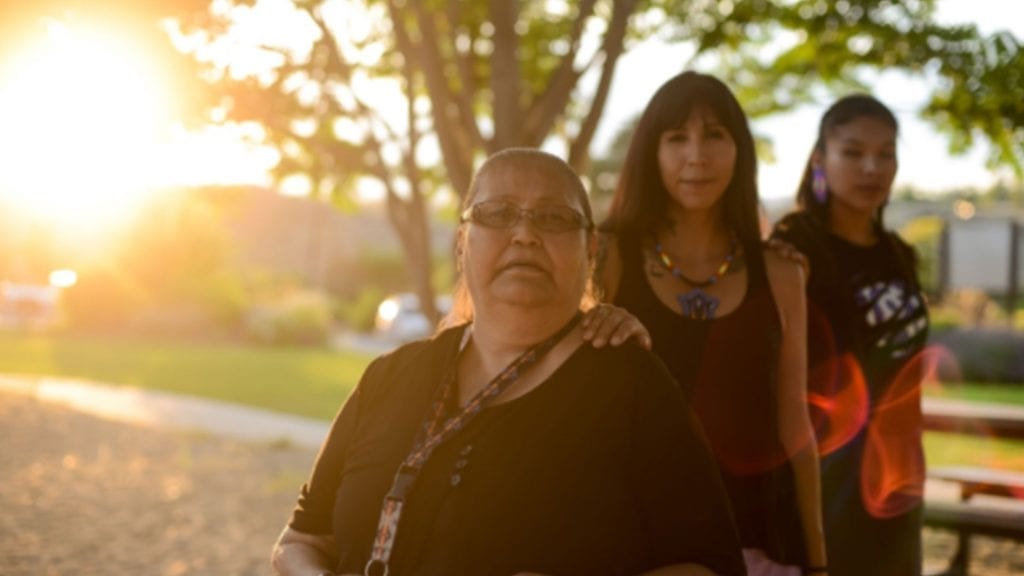
(Rose Caldwell, Jamie Stimson and Moonlite Supernault have helped each other become the women they are today through hanging onto hope. Photo by Kelsie Kilawna)
Editor’s note: This story could be triggering and includes the content of violence, both physical and sexual.
The waves were crashing on the shores of Westbank First Nation (WFN) community beach when I met with three generations of Syilx women to talk about how intergenerational trauma has impacted their family and how they are healing today.
When I arrived, the women were sitting together on the beach, sharing loud, unapologetic laughter before we started storytelling. The stories they carry are powerful, like the Syilx waters.
The effects of intergenerational trauma continue to impact Indigenous families every day. Nations, communities and families are coming together in their own ways to begin the healing process.
Rose Caldwell is a 63-year-old grandmother, mother and aunt who works as a language revitalization teacher. She’s spent her life raising several children and working to keep her family together.
Caldwell raised her daughter Jamie Stimson, a 40-year-old university student, on WFN. Stimson and Caldwell together raised Moonlite Supernault. The 19-year-old is Stimson’s daughter and also a university student.
Both Stimson and Supernault are studying at the University of British Columbia’s Okanagan campus (UBCO). While Supernault is working towards a degree in education with a focus on Indigenous studies, Stimson is working towards a degree in psychology with a minor in women’s studies.
How these women got to this place in their lives is an inspirational story. They’re telling it to create space for others to share their stories and to garner hope by removing the shame of intergenerational trauma.
“My ultimate goal for my daughter, my grandkids – and God-willing I’ll be able to see my great-grandkids – is for them to get beyond trauma as being normalized. Get beyond living in survival mode, know what it’s like to just live, to exist,” says Caldwell.
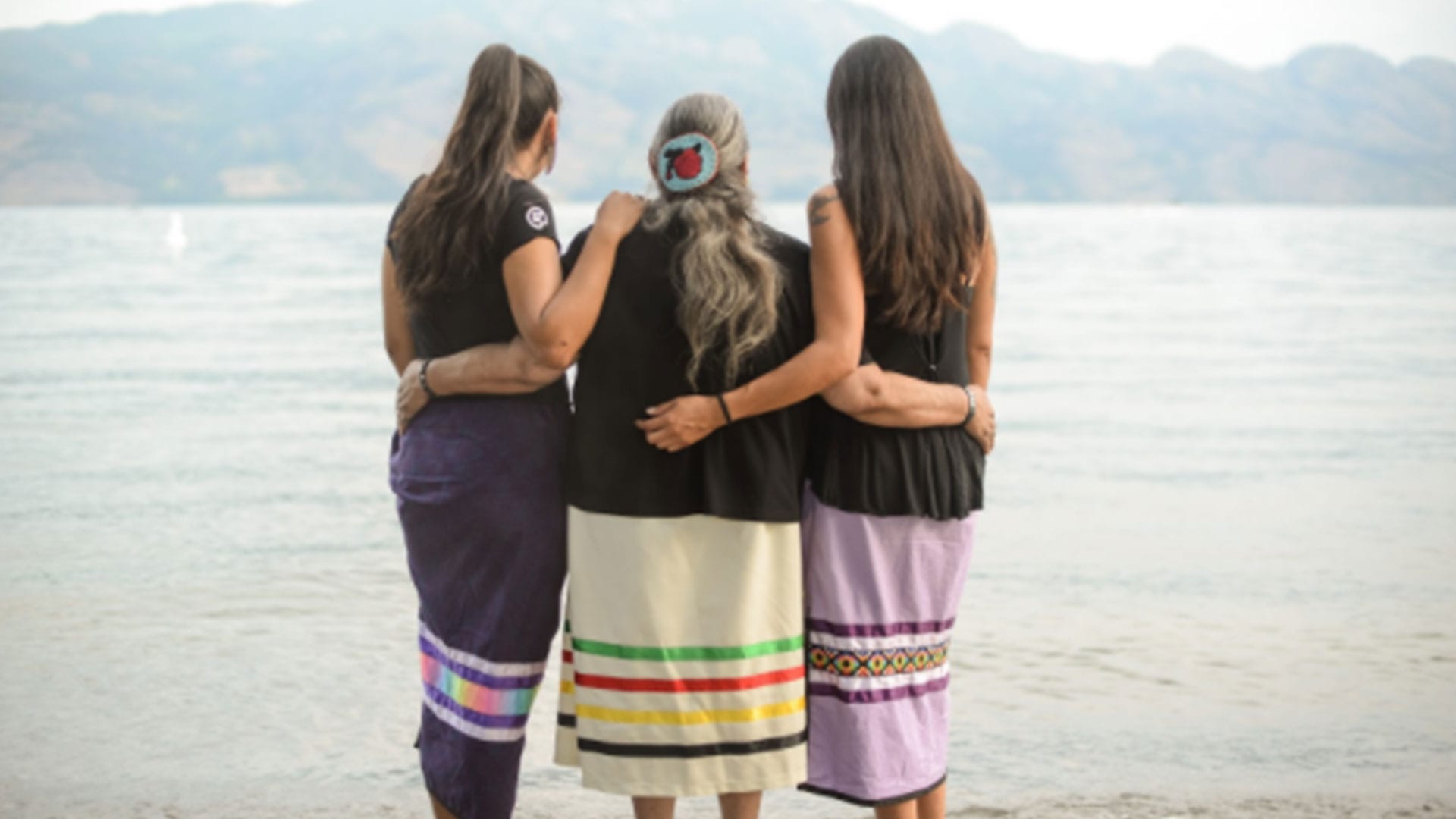
Family history
When Caldwell was a young child, she lost both parents at different times in their lives due to alcohol-related and induced causes. It was at the time of her mother’s death when she was only 12 years old that she says she made a promise that would impact not only her life but the lives of many.
“I made some promises on her grave that I wouldn’t die of alcohol-related things and that I would make sure the family stayed together,” she says.
It’s this promise that Caldwell says led her to have a hand in raising more than 35 children, most of whom she says were extended family members throughout her lifetime.
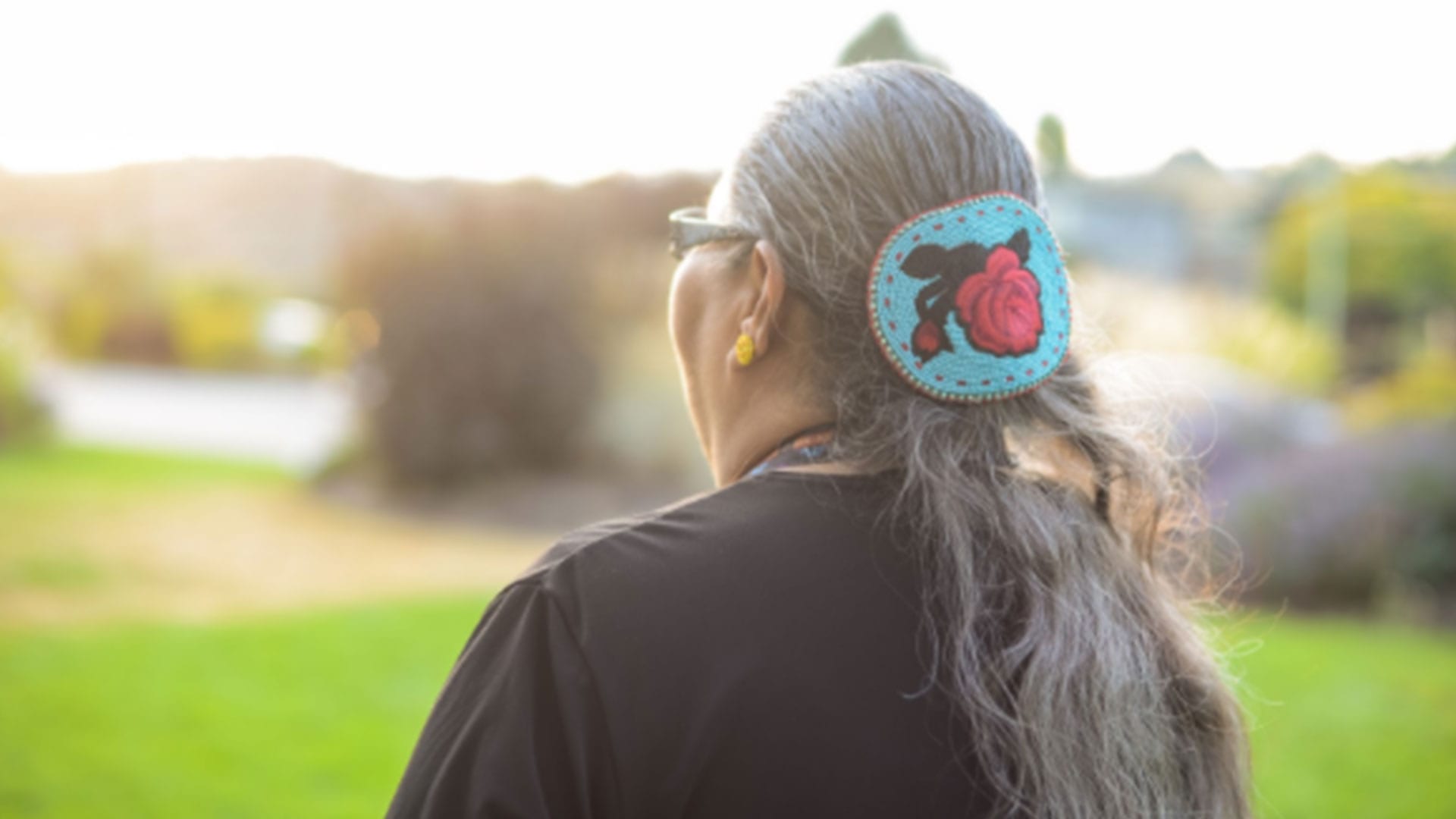
“I don’t have aunts and uncles, they all passed away before I was born,” she says, adding that most of her grandparents passed before she was born as well.
“I knew my grandpa, he passed away when I was three and I barely remember him. So it was very important for me, it was a major commitment in my life to have all our kids stay together.
In 1976, Caldwell says she was the first person in her family to graduate from high school. Afterwards, she moved from Westbank to Nespelum, Wash. There, she lived with her boyfriend but, she says, the relationship turned violent so she moved home.
“I had a brother working in Calgary, so the family sent me there to get away and be safe,” says Caldwell, explaining that her abuser tried to follow her home and bring her back to Washington.
It was while she was living in Calgary that Jaimie Stimson, her niece, came into her life.
At the time, Caldwell says she and her partner both had good jobs. Caldwell was working as a stockbroker.
“We came home one [after] night being out and about and these two little girls aged about 10 and 12 brought Jamie to my house, said they were babysitting for about four days and had no food or diapers for her.”
“And If I didn’t take her they were going to leave her at the steps of a church. They said they had no idea where her mom was so I kept her,” says Caldwell.
This was a decision that Caldwell says she will always be grateful for.
“I never ever regret taking her,” she says.
A traumatic turn
It’s been nearly four decades since Stimson moved in with Caldwell. Her father is Caldwell’s younger brother, and her mother was from Siksika Nation.
“My mother was murdered in the streets of Calgary. She was a part of the street life, so that’s how I ended up with mom Rose,” says Stimson.
While Stimson was still very young, the family moved back to Westbank. She remembers her early childhood fondly.
“I remember as a young girl going to powwows, I’m a dancer, and going to ceremonies,” says Stimson. “My mom would have these Sunday dinners, and everybody on the reserve would come to our sweats.”
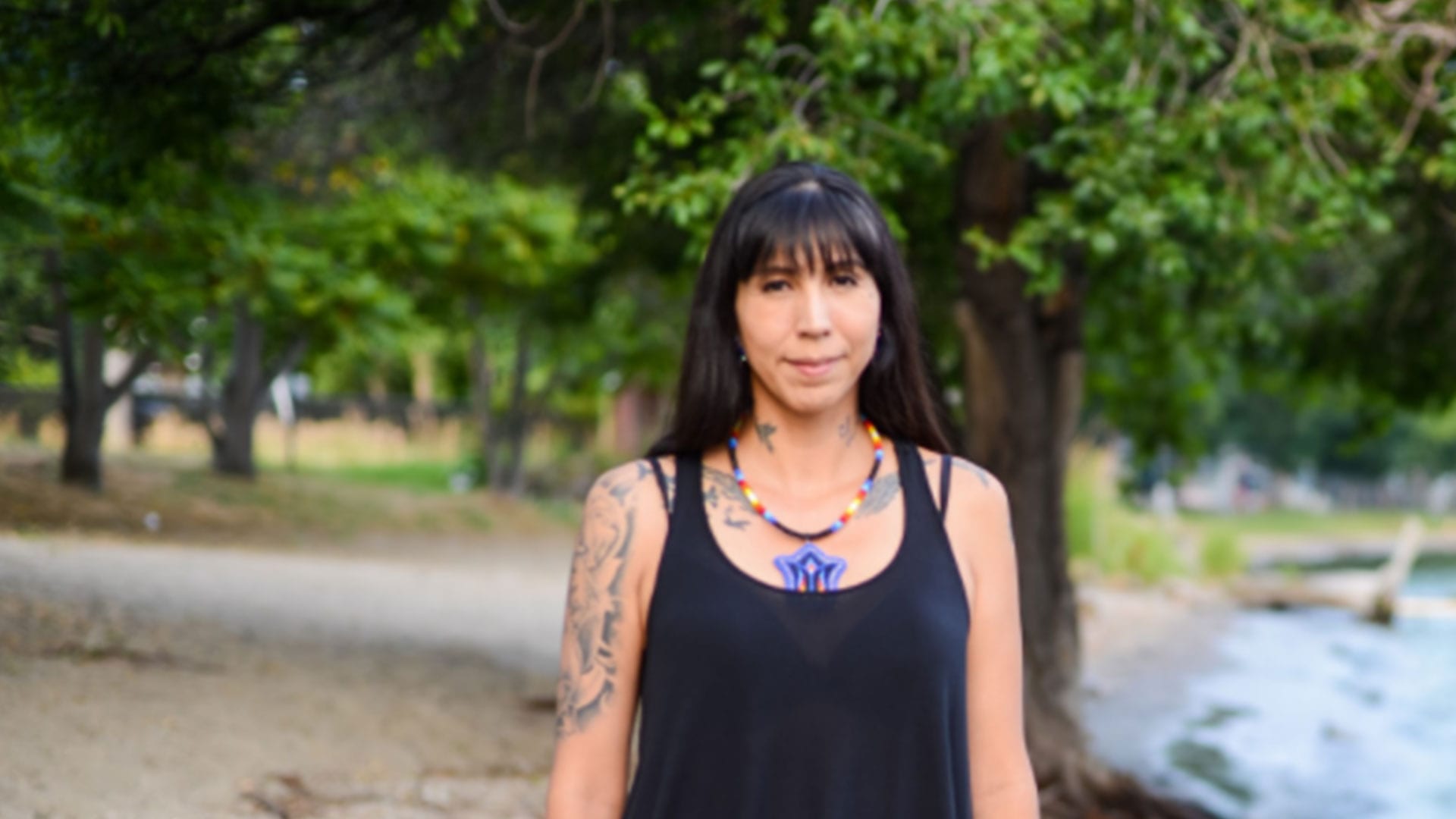
During her childhood, Caldwell kept Stimson active in ceremony and sports. However, when Stimson was a teen, she says she became rebellious and went against the guidance of her mom.
“When you’re growing up as a teenager, you want to rebel and do everything all the other kids are doing, and back then, I didn’t see that and looking back, I’m kicking my ass wishing I had listened,” says Stimson.
This is where Stimson’s journey took a turn.
“My addictions were a coping mechanism to feelings of my mental illness because I was very hyper, and I suffered from ADHD, but I never understood it.”
And then two things happened that Stimson wasn’t expecting. The first, her mother and stepfather separated after 12 years together. She says she took it hard.
Then, at 15 years old, she was sexually assaulted at a party in her community.
“It was like my innocence was gone after that, so after 15, everything just went down, and I felt this anger, but I didn’t understand how to deal with my emotions or my trauma, and I didn’t get any help,” shares Stimson.
“I had to lash out, and I had to blame people. I blamed my community, I blamed my mom, so I ended up running away from here,” she says.
Stimson says she hitchhiked by herself to Calgary, where she found fighting to be a way to cope. She was often picking fights with groups of girls just to feel the pain: “I liked the pain, the self-harm, the drinking, and that was my coping mechanism.”
After living in Calgary for a year, her family encouraged her to move back home to her family in WFN. So, at 17, Stimson packed up and moved back home to the Caldwells.
She and her mom began to rekindle their relationship, but then came another unexpected setback. When her mom was away, Stimson was violently attacked during a home invasion.
It left her again feeling unsafe in her community.
The next generation
Despite these traumatic experiences, Stimson tried to move forward. She got herself involved in the Native Youth Movement, where she spent time among other traditional youth. This is where she met her daughter’s father.
Stimson says it was love at first sight, and she felt protected by him. The couple spent six years together and had two children, Moonlite and her brother Wind Dance Supernault. She shares that her heart was full when looking at Moonlite, her first daughter.
“Blissful adoration, surreal and pure joy. A mini me, she definitely came out shining bright like a full moon night. Everything went dark around, the pain went away and all I could see was her beautiful face.”
The couple spent four years of their relationship sober. But Stimson says it was her struggle with alcoholism that led to the relationship dissolving.
“We started drinking again, and a lot of my past came up and a lot of his past from intergenerational trauma ‘cause he had his own traumas.”
Shortly after the relationship ended with Supernault’s father, Stimson met the father of her two youngest children. Stimson said she always had a dream of normalcy, and that’s what this relationship provided her.
“I always had this vision that I wanted to be normal.”
“I wanted to live off-reserve, I wanted to have the house, and the white picket fence, and work, and I finally met a guy where he was working, and I got to stay home and be a momma and take care of the kids.”
“I was living this fantasy,” she shares.
After seven years with the father of her younger children, Stimson says finances ended up being the main reason the relationship ended.
“I was just pushing all my feelings and emotions, and I ended up arguing about the money, and if money wasn’t an issue, we’d probably still be together,” she says.
After an argument over money, Stimson says she felt defeated and went to the casino, where she ordered a drink after six years of sobriety. Just after she ordered her drink, she looked up and remembers seeing her old drug dealer.
“I got a drink, and an old dealer walks by. And just like that, I relapsed, from being six years clean and sober,” she says.
Stimson shares that addictions had taken over, and it turned her into a person she didn’t like.
“My addictions are my worst enemy because I’m just a different person when I’m in my addictions. I lose everything, and I’m very egotistical.”
So Stimson went to treatment, but during her time there, she found out her youngest children’s father had moved onto a new relationship, and she says she didn’t take the rejection well.
“It was devastating to my self-esteem, and everything, and I walked right out of treatment and relapsed.”
“Then I came back and was like nope, we’re not going down that path. So I started being clean and sober again, and my mom got me a job where she worked,” she says.
However, Stimson knew over the next few years that she still hadn’t worked through her past. She met a man on Facebook and recalls him inviting her down to Tacoma, Wash., for the weekend.
This trip led to another relapse.
“I go out there and, of course, we started drinking,” she says. “He introduced crystal meth to me, and my weekend trip down there ended up lasting two years.”
Stimson then lived a life on the streets of Tacoma, where she says meth took over. She describes living a life of enduring abuse, sex trafficking and violence on the streets.
It was when Stimson went to jail that she made her most significant decision to date.
“I was begging God to give me a second chance. I said if you get me back home to Canada, I promise I’ll get off the streets, and I’ll stop using and then eventually, I just fell asleep.
“The next day, little miracles started happening,” she says. “I got in touch with my mom, the judge said I would be out of jail on a certain day.”
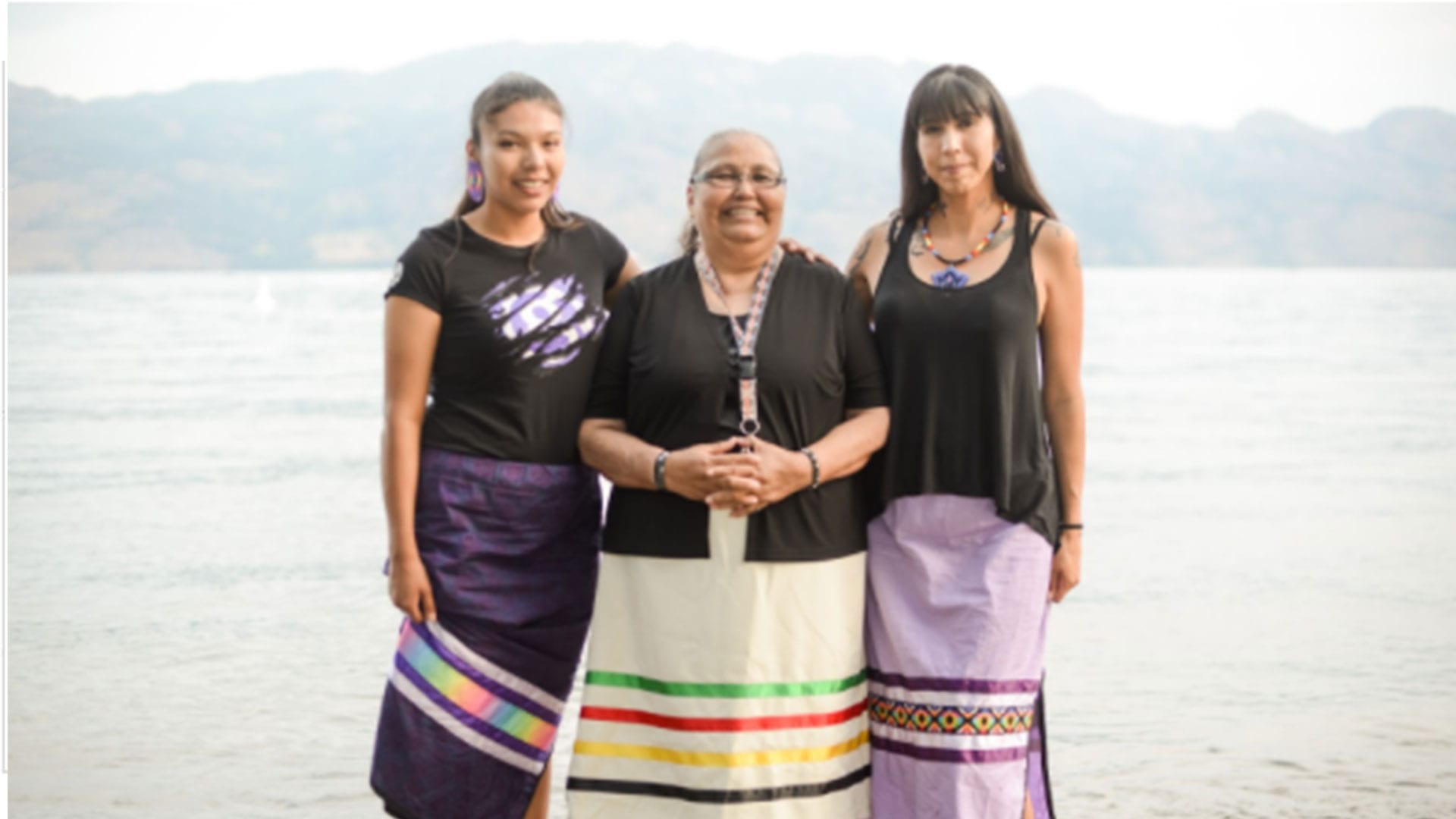
After her 32 days in jail and 32 days of detoxing, Stimson remembers being excited when her mom showed up in Tacoma to pick her up. Once across the border with Caldwell, the first person she saw was her son.
“I walked into her house after two years, my son is laying on the couch, and he was sleeping, and I went and sat down beside him, and I started crying,” she says.
“I said ‘God, I need you by my side, I need your strength, I need your guidance, I need your wisdom, I know this is not going to be easy, I know I need patience, I need to make amends, I know it’s going to take a while to get trust back, I need to get myself into a treatment centre.’ I had all my thoughts going into this prayer.
“I knew right there and then that God kept his promise, and now it was time to keep mine,” says Stimson.
After a lot of hard work to reunite with all her children, it came time to begin making amends.
The hard work begins
Moonlight Supernault says that it was difficult to be reunited with her mother at 16 years of age. She says she had built up resentment over the things she needed to endure in her mother’s absence.
At the time when Stimson said she was leaving for the weekend and went to Tacoma, Supernault says she and her mother got into a big argument.
It was a few days later that she received a message saying that Stimson wouldn’t be back.
“I just felt really guilty because I wished her away, and then she was gone, and it felt so surreal to me,” says Supernault as she begins to cry.
She immediately began to think about the impact this would have on her younger siblings.
“I read the message and thought I should be mad, I should feel in shock or something, but I just couldn’t feel anything. And I thought there was something wrong with me,” she shares.
“All I could think about was my brother and sister, and I was like, how are we going to tell them?”
Supernault shares that although she was upset with her mother, she also understood her.
“I understood. I knew she became a young mother; I knew she didn’t have the chance to be young and wild,” she says.

Caldwell says that, over the next two years, she and her granddaughter went into ceremony together (out of respect for the tradition, we won’t name them here). However, they prayed for two years together, with the nation, and individually to bring Stimson home.
“I really believe that is a big reason why she came home, because she heard our prayers,” says Caldwell.
Supernault and Caldwell remember having the two younger siblings every weekend. Supernault says she ended up becoming a parent alongside her grandmother.
It was these responsibilities of mothering her siblings that took an emotional toll on her.
“I would have to have tough conversations with them, like, ‘Is mom going to come back?’ ‘When is mom going to come back?’” she says.
“And I would just have to tell them that she loves us and we’re not sure when she was going to come back, and we would have to just keep sending good thoughts out there.”
Supernault’s father then told her it was time for him to go back home to his community, and she decided to go with him. It was there that Supernault says she turned to alcohol to cope.
For Supernault, after losing so much control in her life and recognizing she needed her family back in the Okanagan, she decided it was time to move home. That’s when she got the call.
“I got the call that my mom was home,” she continues, “everything that I was feeling and that I was suppressing for so long, for two years, all hit me, and I knew I wanted to go back.”
But seeing her mom for the first time in two years wasn’t easy.
“I just wanted to cry, I just wanted to break down in her arms and say, ‘I missed you,’” she shares.
“Literally for two years, I didn’t even know if she was alive or not, and I didn’t realize how much that affected me until I saw her.”
Then feelings of doubt started to follow, and Supernault put up a guard that would protect her from being hurt by her mother again.
“I didn’t give her an easy time. … She had addictions before, and she tried to get sober before, so what makes it different this time? How do I know it’s for real this time?”
That’s when she and her mother went on a hike, and Supernault recalls Stimson sharing a sincere apology that left no room for excuses.
“I made my amends to her. I told her I was sorry I left. It had nothing to do with them, and there was no excuse for that and I wanted to just say I’m sorry,” says Stimson. “It was a really emotional hike.”
After mother and daughter began to reconnect, they decided it was time to go to counselling together to strengthen their healing with one another.
Looking ahead
Supernault and Stimson decided counselling was going to be the first step towards building a stronger relationship with one another. Which they say is a big reason they now understand one another on a more connected level.
“We went through our counselling, and we were able to talk and to communicate about our triggers and about how to talk to each other when we’re mad,” Supernault continues. “We’re still healing, and we’re still working on it every single day.
“I’m very happy for that time that we went through, and I realized that I needed my mom, and I was very happy to have her back, and I’m very happy to be able to work through my emotions with her,” shares Supernault.
“Now, we’re in university together,” says Stimson.
She adds that going to long-term recovery, wellbriety meetings and ceremony is what has kept her on a path to reclaiming her family.
“Like I said before, I never really dealt with anything, and I had relapsed six times in my past and when I came back, I said, nope, not no more,” Stimson continues. “You are going to face those fears, you’re going to face those traumas, and you’re going to deal with them.”
Stimson says now her mother and her daughter have all accepted they have experienced mental health issues due to intergenerational trauma and have started a collective healing journey.
“The healing really started to begin. …We all have these different mental health issues, and what I love about it is now we’re coming together, healing together,” Stimson says.
“Because that’s what we want to break – is that intergenerational cycle.”
Sharing teachings
As the waves continue to crash, the women share what their hopes and dreams are for the future generations in their family.
“I want them to be fearless, I want them to attack this world head-on, I don’t want them to think of themselves as being less than the white man,” says Supernault.
“I want them to be compassionate, I want them to be strong and to fight their fears, and I want them to be strong like my grandma, like my mom, like my dad, like my brother.”
“All that good I see in everyone, I want that for them. I want that to shine the most,” shares Supernault.
Stimson says she wants her future grandchildren to also live without fear and anxiety.
“I don’t want them to live a life where they have to survive,” shares Stimson. “I want them to wake up without fear, because anxiety comes from fear, and I want them to be away from that.”
She also wants them to “grow up without them being in a home of addictions…And that they know we are all one, we are all Syilx, we’re not rez, we’re Syilx.”
The advice these women would give to others?
They say that it’s time to address the traumas of others by listening to one another and showing unconditional love to bring each other home.
“Unconditional love, there has to be unconditional love,” says Caldwell, “She [Stimson] had to go through what she had to go through and now that she’s gone through it she still needs to know that there is still more work that needs to be done.
“Our responsibility as Syilx People, it is our job and our duty to give back to the land and to the Timxw, which is the spirits all around us, we owe it all back to the land,” says Caldwell. This is a driving force in the healing of the people, through ceremony on the land.
Stimson says it’s essential in a healing journey to remain a listener, to stay humble, and to always appreciate the voices of those around you, especially your children.
“They [children] are our teachers as well, and that’s a lot of what I didn’t do, I didn’t listen to her. I felt like I knew more, I was the mom, and that’s all I want to do now is listen.”
“Having love and acceptance for yourself, because we are all human beings and we all have those emotions too, and to feel our emotions is to embrace them,” she continues.
“Our vulnerability should not be our weakness, our vulnerability should be our strength.”
And for Supernault, her message to other youth like herself is to strengthen your identity.
“A lot of things are going to hurt you in this world, and a lot of things are going to make you scared, but in the end, you are your own strength,” she says. “The hardest thing you are going to work on in this life is you, so figure out who you are and figure out what you want in this world.
“Not just career goals, or capitalist ideologies, but who do you want to be? And keep that in mind.”
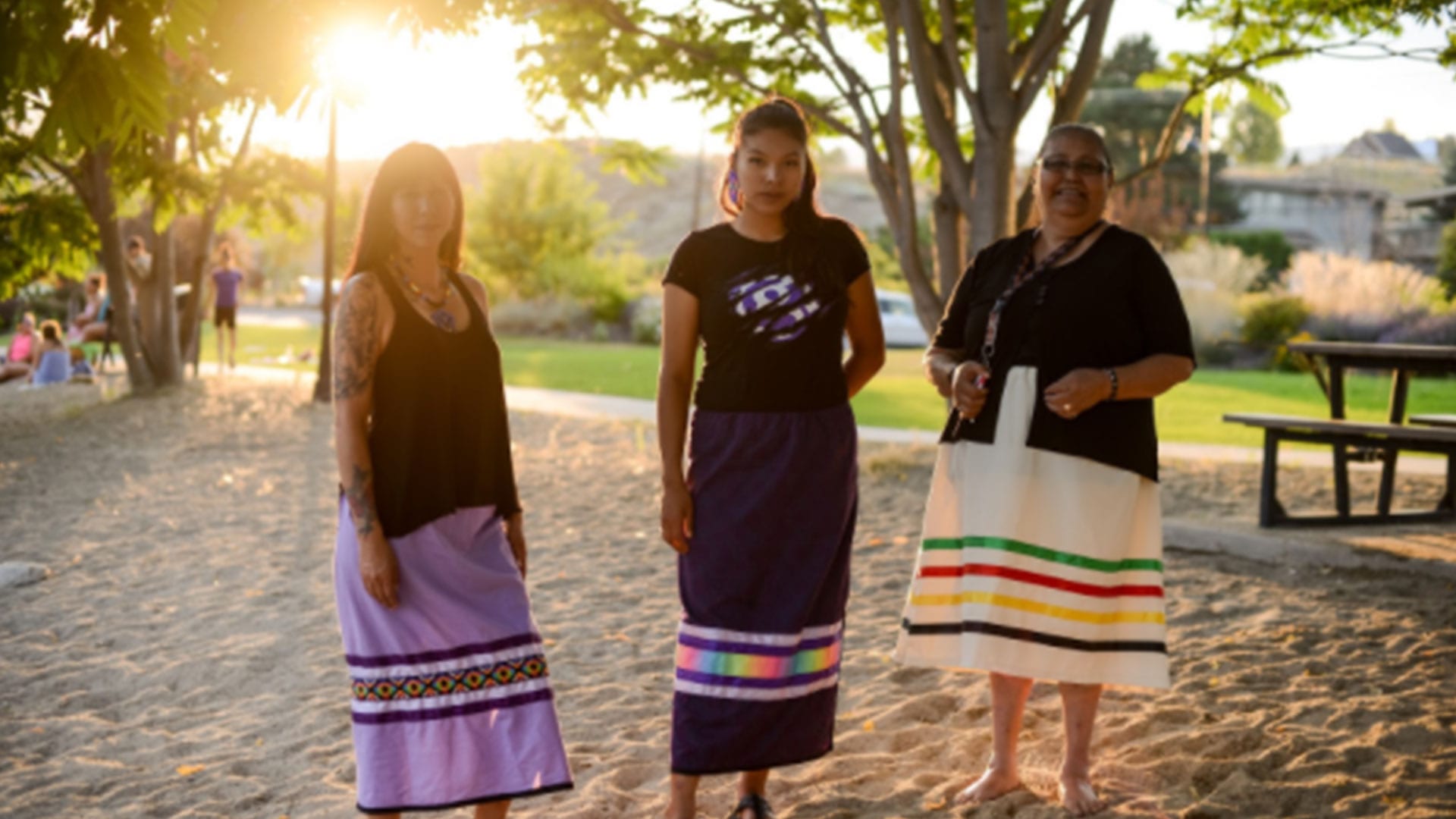
So as Stimson continues her walk of recovery and reclamation, Supernault works towards her degree and healing with her mother.
Caldwell continues to teach and revive the Nsyilxcen language, instructing over 500 children a week. She says that no matter who you are, you will always have your teachings alive in your blood.
“So the teachings are there, it’s in our blood, and it doesn’t matter how removed you are, you could’ve been adopted out from the hospital and lived in a white home in Ireland, and you would still have those teachings. It’s in your blood, and that can’t change.
“Our teachings are always there. They will never leave us, even if you never heard anything about it. I believe that to the core of my soul, I believe that.”










